
Concept explainers
(a)
Interpretation: The class of given cycloocta-1,4-diene as isolated, conjugated, cumulated, or a combination is to be stated.
Concept introduction: Conjugated systems have alternate single and double bonds that results in lower the energy and increase the stability of a molecule. Isolated dienes or polyenes are the compounds that comprise double bonds at the large distances separated by more than one single bond, whereas cumulated dienes or polyenes are the compounds that do not possess any single bond in between the two double bonds.
(a)
Answer to Problem 15.24SP
The given compound is classified as isolated diene.
Explanation of Solution
The structure of given diene is shown in figure 1.
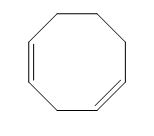
Figure 1
It is conferred from the above structure of
(b)
Interpretation: The class of given cycloocta-1,3-diene as isolated, conjugated, cumulated, or a combination is to be stated.
Concept introduction: Conjugated systems have alternate single and double bonds that results in lower the energy and increase the stability of a molecule. Isolated dienes or polyenes are the compounds that comprise double bonds at the large distances separated by more than one single bond, whereas cumulated dienes or polyenes are the compounds that do not possess any single bond in between the two double bonds.
(b)
Answer to Problem 15.24SP
The given compound is classified as conjugated diene.
Explanation of Solution
The structure of given diene is shown in figure 2.
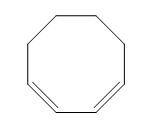
Figure 2
It is conferred from the above structure of
(c)
Interpretation: The class of given cycloocta-1,2-diene as isolated, conjugated, cumulated, or a combination is to be stated.
Concept introduction: Conjugated systems have alternate single and double bonds that results in lower the energy and increase the stability of a molecule. Isolated dienes or polyenes are the compounds that comprise double bonds at the large distances separated by more than one single bond, whereas cumulated dienes or polyenes are the compounds that do not possess any single bond in between the two double bonds.
(c)
Answer to Problem 15.24SP
The given compound is classified as cumulated diene.
Explanation of Solution
The structure of given diene is shown in figure 3.
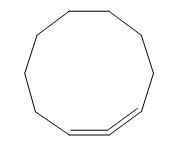
Figure 3
It is conferred from the above structure of
(d)
Interpretation: The class of given cycloocta-1,2,5,7-tetraene as isolated, conjugated, cumulated, or a combination is to be stated.
Concept introduction: Conjugated systems have alternate single and double bonds that results in lower the energy and increase the stability of a molecule. Isolated dienes or polyenes are the compounds that comprise double bonds at the large distances separated by more than one single bond, whereas cumulated dienes or polyenes are the compounds that do not possess any single bond in between the two double bonds.
(d)
Answer to Problem 15.24SP
The given compound is classified as conjugated polyene.
Explanation of Solution
The structure of given polyene is shown in figure 4.
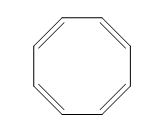
Figure 4
It is conferred from the above structure of
(e)
Interpretation: The class of given cyclohexa-1,3,5-triene as isolated, conjugated, cumulated, or a combination is to be stated.
Concept introduction: Conjugated systems have alternate single and double bonds that results in lower the energy and increase the stability of a molecule. Isolated dienes or polyenes are the compounds that comprise double bonds at the large distances separated by more than one single bond, whereas cumulated dienes or polyenes are the compounds that do not possess any single bond in between the two double bonds.
(e)
Answer to Problem 15.24SP
The given compound is classified as conjugated polyene.
Explanation of Solution
The structure of the given polyene is shown in figure 5.
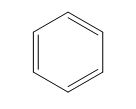
Figure 5
It is conferred from the above structure of
(f)
Interpretation: The class of given penta-1,2-4-triene as isolated, conjugated, cumulated, or a combination is to be stated.
Concept introduction: Conjugated systems have alternate single and double bonds that results in lower the energy and increase the stability of a molecule. Isolated dienes or polyenes are the compounds that comprise double bonds at the large distances separated by more than one single bond, whereas cumulated dienes or polyenes are the compounds that do not possess any single bond in between the two double bonds.
(f)
Answer to Problem 15.24SP
The given compound is classified as cumulated and conjugated polyene.
Explanation of Solution
The structure of given polyene is shown in figure 6.
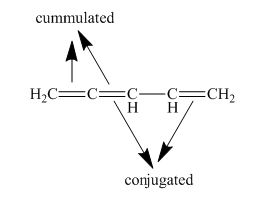
Figure 6
It is conferred from the above structure of
Want to see more full solutions like this?
Chapter 15 Solutions
Pearson eText Organic Chemistry -- Instant Access (Pearson+)
- Design experiments in UV-Vis to figure the optimal mole ratio of copper (1:1, 2:1, 3:1 and etc)versus ethambutol using all necessary chemicals including dihydrochloride and copper nitrate hemipentahydrate and sodium hydroxide. Show how UV-Vis absorbance and maximum wavelength would change in responsearrow_forwardCorrect each molecule in the drawing area below so that it has the condensed structure it would have if it were dissolv a 0.1 M aqueous solution of HCI. If there are no changes to be made, check the No changes box under the drawing area. No changes. HO—CH,—C—CH,—OH X 5 2 2 2 HO–CH,—CH,—C—CH,—OH Explanation Check Center Accessi ©2025 on 5 Carrow_forwardMake the calculations to prepare 2M H2SO4, from concentrated H2SO4 (98%; density: 1.84 g/mL).arrow_forward
- H CH3 CH3 b) Write the products of your compound and the following reagents. If the reaction would not work for your compound, write "no reaction" and explain the problem. NaCN H* H₂NNHCH5 H* -à NaBH -à CH2MgBr Cro₁₂ --à H3O+ -à c) Would your compound give a positive Tollen's test? Why or why not?arrow_forwardHomework 4 Chem 204 Dr. Hellwig Consider this compound, which will be referred to as "your compound". a) Name your compound according to the IUPAC system. Include stereochemistry (E/Z/R/S) H CH3 CH3arrow_forwardWhat is the mechanism for this?arrow_forward
- 21.50 Determine the combinations of haloalkane(s) and alkoxide(s) that could be used to synthesize the following ethers through Williamson ether synthesis. (a) (c) (d) (e) (f) H₂COarrow_forward1. Arrange the following in order of increasing bond energy (lowest bond energy first, highest bond energy last). Provide your rationale. C=C, C-F, C=C, C-N, C-C List the bond order for each example.arrow_forwardWhat is the major enolate formed when treated with LDA? And why that one?arrow_forward
- 4. Calculate the total number of sigma bonds and total number of pi bonds in each of the following compounds. a. HH :D: +1 I H-N-C-C-O-H I H b. HH H Н :N=C-C-C=C-CEC-H :0: total o H-C-H H-C = `C-H I H. 11 H-C = C= CH H total o total π total π 1 Harrow_forwardIn the following reaction, what quantity in moles of CH₃OH are required to give off 4111 kJ of heat? 2 CH₃OH (l) + 3 O₂ (g) → 2 CO₂ (g) + 4 H₂O(g) ∆H° = -1280. kJarrow_forwardIndicate the processes in the dismutation of Cu2O.arrow_forward
 ChemistryChemistryISBN:9781305957404Author:Steven S. Zumdahl, Susan A. Zumdahl, Donald J. DeCostePublisher:Cengage Learning
ChemistryChemistryISBN:9781305957404Author:Steven S. Zumdahl, Susan A. Zumdahl, Donald J. DeCostePublisher:Cengage Learning EBK A SMALL SCALE APPROACH TO ORGANIC LChemistryISBN:9781305446021Author:LampmanPublisher:CENGAGE LEARNING - CONSIGNMENT
EBK A SMALL SCALE APPROACH TO ORGANIC LChemistryISBN:9781305446021Author:LampmanPublisher:CENGAGE LEARNING - CONSIGNMENT

